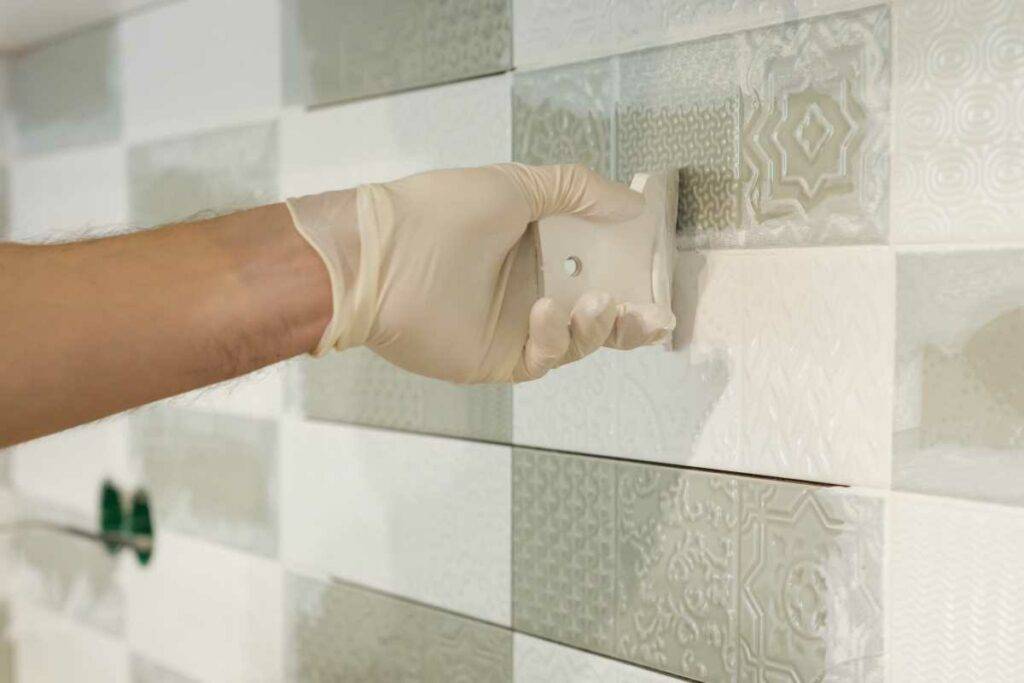As an architect with a passion for both structural integrity and aesthetic beauty, I always emphasize the importance of the finer details in any construction project. One of the most critical yet often overlooked aspects of tile installation is grouting. Proper grouting not only ensures that tiles are securely held in place, but it also enhances the overall look and longevity of the installation.
How to Grout a Tile?
Before diving into the grouting process, it’s important to ensure that the tile installation is ready for grouting. This preparation phase is crucial for a successful outcome.
Allowing the Tile Adhesive to Cure
If you’ve recently installed the tiles, you need to allow sufficient time for the tile adhesive to cure. Generally, this takes at least 24 hours, but it’s always best to follow the manufacturer’s instructions for specific curing times. Premature grouting can lead to tile movement and a compromised bond.
Cleaning the Tile Surface
The tile surface must be clean and free of debris before grouting. Use a vacuum or damp cloth to remove any dust, dirt, or adhesive residue. Pay special attention to the grout lines, ensuring they are clear and ready to receive the grout.
Choosing the Right Grout
Selecting the appropriate grout is critical for a successful installation. There are two main types of grout: sanded and unsanded. Sanded grout contains fine sand particles, providing added strength for wider grout lines (over 1/8 inch). Unsanded grout is smoother and is best suited for narrower grout lines (1/8 inch or less). Choose a grout color that complements your tile, as the color can significantly affect the overall appearance of the finished installation.
Gathering Tools and Materials
Having the right tools and materials on hand is essential for a smooth grouting process. Here’s what you’ll need:
- Rubber grout float
- Bucket for mixing grout
- Margin trowel
- Sponge
- Clean water
- Grout sealer (for later)
With these tools and materials ready, you can begin the grouting process.
Grouting the Tile
Grouting requires a steady hand, patience, and attention to detail. Follow these steps to achieve a professional finish.
Step 1: Mixing the Grout
Start by following the manufacturer’s instructions to mix the grout. The ideal consistency is thick but workable—similar to toothpaste. Use a margin trowel to mix the grout thoroughly, ensuring there are no lumps or dry spots. Let the grout sit for a few minutes to “slake,” allowing the chemical reactions to stabilize, then give it another quick mix before applying.
Step 2: Spreading the Grout
Using a rubber grout float, scoop a generous amount of grout onto the tile surface. Hold the float at a 45-degree angle and press the grout into the joints, spreading it evenly across the tiles. Apply firm pressure to ensure the grout fills the joints completely. Work in small sections, focusing on one area at a time. This methodical approach ensures even coverage and minimizes waste.
Step 3: Removing Excess Grout
After spreading the grout over a section, use the float to remove excess grout. Hold the float at a shallow angle and scrape diagonally across the tiles. This technique avoids pulling grout out of the joints and leaves the surface smoother. Don’t worry about a thin film of grout on the tiles—that will be removed in the next step.
Step 4: Cleaning the Tile Surface
Once you’ve completed grouting an entire section, let the grout set for about 10-15 minutes. During this time, the grout will begin to firm up, but won’t be completely dry. Use a damp sponge to gently wipe the tile surface, removing any excess grout. Rinse the sponge frequently to keep it clean, and avoid using too much water, as this can weaken the grout. The goal is to leave the grout lines smooth and even while cleaning the tile surface.
Step 5: Final Cleaning and Curing
After you’ve finished grouting and cleaning the tile surface, let the grout cure for at least 24 hours. This curing period allows the grout to harden and bond with the tiles. Once the grout has cured, use a dry cloth or cheesecloth to buff the tiles and remove any remaining grout haze. This step is crucial for achieving a clean and polished look.
Sealing the Grout
Sealing the grout is an important step that helps protect it from moisture, stains, and mildew. This is especially important in areas like bathrooms and kitchens, where tiles are frequently exposed to water.
To seal the grout, follow these steps:
- Choose a Grout Sealer: There are different types of grout sealers available, including penetrating sealers and membrane-forming sealers. Penetrating sealers are ideal for most tile installations, as they protect without altering the appearance of the grout.
- Apply the Sealer: Use a small brush or applicator bottle to apply the sealer to the grout lines. Be careful not to get sealer on the tiles, as it can leave a residue. Follow the manufacturer’s instructions for drying times and reapplication, if necessary.
- Allow the Sealer to Cure: After applying the sealer, allow it to cure for the recommended time, typically 24 hours. Avoid getting the tiles wet or walking on them during this period.
The Importance of Proper Grouting
Grout serves several essential functions. It holds tiles together, fills the gaps between them, and provides a finished look. Additionally, it prevents debris and moisture from seeping into the underlying substrate, reducing the risk of damage and mold growth. As an architect, I know that even the most beautiful tile layout can be undermined by poor grouting. That’s why proper grouting techniques are crucial for both structural integrity and aesthetics.
Conclusion
Grouting tile may seem like a straightforward task, but it requires careful attention to detail and proper technique. Following the steps outlined in this guide, you can achieve a professional finish that not only looks great but also ensures the structural integrity and longevity of your tile installation. Remember, preparation is key—make sure the tile surface is clean, the grout is mixed to the correct consistency, and the tools are readily available.
By sealing the grout, you add an extra layer of protection against moisture and stains, which is crucial for maintaining the appearance and durability of your tiled surfaces. If you’re ever in doubt during the grouting process, don’t hesitate to seek advice from a professional or an experienced tile installer.
With these tips and guidance, you’re well on your way to achieving a beautifully grouted tile installation that will enhance the aesthetic appeal of your home and withstand the test of time.
How do I choose the right grout color for my tile?
Choosing the right grout color depends on your desired aesthetic. If you want the tiles to stand out, choose a grout color that contrasts with the tiles. For a more seamless look, choose a grout color that matches or complements the tile color. Neutral colors like gray, white, and beige are popular choices because they blend well with most tile designs. When in doubt, you can test a small section with different grout colors to see how they look with your tiles.
How do I prevent grout from cracking over time?
To prevent grout from cracking, ensure that the tile installation is stable and the grout is properly applied. Avoid using excessive water when mixing or cleaning grout, as this can weaken it. Make sure the grout lines are filled completely, with no air pockets. Additionally, sealing the grout can help protect it from moisture and reduce the likelihood of cracking. If you notice cracks developing, it may be necessary to remove the old grout and reapply it.
Can I grout over old grout, or do I need to remove it first?
It’s generally best to remove old grout before applying new grout. Grouting over existing grout can result in a weak bond and an uneven appearance. If the existing grout is cracked or discolored, use a grout removal tool to carefully remove it from the joints. Once the old grout is removed, clean the area thoroughly before applying the new grout. This ensures a stronger bond and a more professional finish. If you’re unsure about removing old grout, consider hiring a professional to ensure the job is done correctly.
Disclaimer: This information is for general purposes only. Consult a professional for specific advice. See ourterms and conditions for details.

